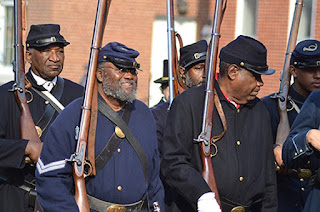 |
| Josephine Baker |
 |
| Elizabeth Van Lew and Family |
 |
| White House of the Confederacy |
The American Civil War Museum and White House of the Confederacy offer daily tours. It has been restored to its appearance during the time of Davis, August, 1861 until April 2, 1865. Many of the furnishings were used by the Davis family. acwm.org
Jefferson Davis’ coachman, William Jackson, was also a household spy. There is documentation that he gave information so important it was passed on to the War Department. He crossed into Union lines in 1862 to Fredericksburg to deliver the information. Driving tours of the battlefield are clearly marked. fredericksburgva.gov
Charlie Wright escaped from Culpepper, VA in 1863 and upon questioning they found he had a remarkable memory for details. He informed the Union that troops were headed into Maryland. Based on Wright’s intelligence Hooker shadowed the Confederates and protected DC from Lee’s forces, held the better ground and led to the Battle of Gettysburg. destinationgettysburg.com
John Scobell was a Mississippi slave whose master educated and freed him. In 1861 he became one of several black Pinkerton agents. He was a master of disguise and often posed as a servant to a white operative to gain information from other black workers. He employed the aid of the Legal League, a secret black southern organization working to free slaves and provided intelligence on troop movements, numbers and fortifications.
Dabney and his wife fled the Confederacy and began to work for Union General Hooker. His wife soon returned south to work in a household as a maid. Dabney began providing incredibly accurate intelligence. When questioned he told the officers that he and his wife sent signals using the positions of the laundry on her line that could be seen from Hooker’s headquarters.
Mary Touvestre was the engineer of the ironclad Merrimac’s housekeeper. She stole the blueprints, left Norfolk and gave them to the US Sec. of the Navy. The Union then sped up the building of their ironclad, the Monitor.
Less is known about Tubman’s role as a troop commander and spy than her work on the Underground Railroad, but her war work is as astonishing, if not more so. She and Colonel James Montgomery planned to raid rice plantations and liberate slaves along South Carolina’s Combahee River. In June of 1863 she led three gunboats of black soldiers down the river. She successfully avoided Confederates and torpedoes due to information she and her spies had gathered. These “commandoes” torched plantations destroying food and supply sources, burned bridges disrupting transport and freed more than 700 people. She sent word ahead that when the boats came they would carry them to freedom and the enslaved people met them and clambered aboard. Approximately 100 of the men later joined the union forces.
Tubman’s wartime salary was $200. She later received her husband’s veteran’s benefits and was to be paid for her nursing services. She did not receive the money owed her until 2003 when Senator Hillary Clinton heard the story. The benefits, adjusted for inflation, of $11,750 were paid to the organization that administers her Auburn home. A statue of Harriet Tubman was placed in the Maryland State House in Feb. 10, 2020 in Annapolis in the Old House Chamber, the room where slavery was abolished in Maryland in 1864. #visitMaryland




























































